Atmosphere
-
Spectroradiometer Optronics OL-754 PMT doble monocromador
Characteristics:- Double monochromator
- Measurement range 280-800 nm, with a bandwith of 0.05 nm
- Detector PMT
- Precision 1 nm
Accesories:- Module for direct radiation measurements
- Laptop for control
-
Characteristics: - Simple monochromator
- Detector PMT silicon tube
- Measurement range 300-1100 nm with a bandwidth of 6 nm
- Precision 1 nm
Accesories:- Module for direct radiation measurements
- Portable PC for control
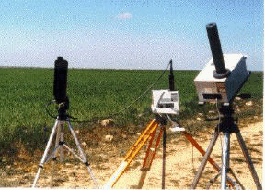
-
Characteristics: - Configured for the measurement of the total ozone column, total water vapour and aerosol optical thickness.
- Filter configuration: 305.5, 312.5, 320, 936 and 1020 nm
- FOV 2.5 degrees
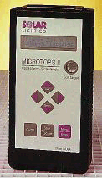
-
Solar Direct Irradiance Reagan Sunphotometer
The Reagan sunphotometer is a sun-looking ground based instrument for atmospheric measurements. In remote sensing applications it is mainly used as ground truth instrument, in field campaigns for atmospheric measurements in order to improve atmospheric correction algorithms. Its continuous monitoring of the state of the atmosphere allows furthermore conclusions on atmospheric stability and daily developments of aerosol contents. 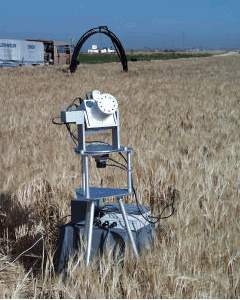
-
Daisex98 sounding: airsondes model AS-1C-PTH and two ballons, completed with an earth station AIR INC. TS-2AR RECEIVER S/N 259, and a barometer NEGRETTI & ZAMBRA.
-
VAISALA RS80 radiosonde and VAISALA RS80 ozonosonde
The Vaisala RS80 radiosonde pressure sensor is a capacitive aneroid with a measuring range from 1060 to 3 hPa and with a resolutien or 0,1 hPa. The temperature sensor is a capacitive bead with a measuring range from +60ºC to -90ºC and with a resolution of 0.1ºC. The humidity sensor is a thin film capacitor with a measuring range from 0 to 100% RH and with a resolution of 1%. 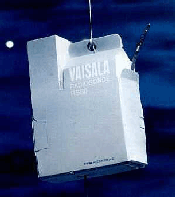
The Vaisala RS80 ozonesonde, has an ECC-6A (electrochemical concentration cell) ozone sensor. The ozone sensor in located inside the white box (a polystyrene waterproof box). The normal PTU Vaisala RS80 radiosonde has been fixed to one of its sides and it has been connected to the ozonesonde through an interface. 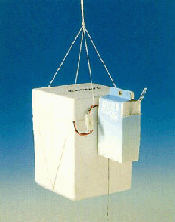
|
Parameter
|
Description
|
| Channels | 10 channels parallel co-aligned FOV tube382, 410, 501, 611, 669, 721, 780, 872, 940, and 1033 nm |
| Field of view | ˜ 3.2° |
| FWHM | ˜ 8 to 12 nm |
| Digitization | 16 bits |
| Temperature stability | At ˜ 43 ± 0.5 °C (by heater control) |
| RS-232 line driver/receiver | |
| Automatic sun tracking | Four quadrant detector technology, ± 17° tracking capability |
VIS/NIR
Radiometry
-
ParameterDescription
Spectral range from 300 to 2500 nm Channels 704 Spectral resolution: 1.5nm from 300 to 1050 nm
6.5 nm from 1050 to 1900 nm
9.5 nm from 1900 to 2500 nm
Scan Time
50 ms FOV circular (6°) Spectrum averaging selectable from 4 to 9
-
ParameterDescription
Spectral range from 350 to 2500 nm Channels 640 Spectral resolution: 1.5nm from 350 to 1050 nm
6.5 nm from 1050 to 2500 nm
FOV 3º standard
10º Option
23º Option with fiber optic
-
ParameterDescription
Spectral range from 350 to 1050 nm Channels 512 Spectral resolution: 1.5nm
FOV 4º standard
Option to 23º
-
Field Goniometer System (FIGOS)
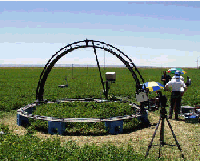 The
FIGOS is a transportable goniometer which is designed to measure BRF under
natural illumination conditions. It has been designed and developed by
the team of the University of Zurich. FIGOS provides essential information
on the BRF of objects in order to overcome the Lambertian assumption.
The goniometer is operated with a GER3700 spectroradiometer. A motor drives
a sledge for semi-automatic progress of the measurements (zenith arc).ParameterDescription
The
FIGOS is a transportable goniometer which is designed to measure BRF under
natural illumination conditions. It has been designed and developed by
the team of the University of Zurich. FIGOS provides essential information
on the BRF of objects in order to overcome the Lambertian assumption.
The goniometer is operated with a GER3700 spectroradiometer. A motor drives
a sledge for semi-automatic progress of the measurements (zenith arc).ParameterDescriptionDiameter/Height 4 m/2 m Possible view angles -75° < t < 75° (where t = zenith angle)0 < f < 360° (where f = azimuth angle) Angular precision ±0.2° Material Blackcoated aluminum Total weight ˜230 kg Time to set up 1.5 h (operating staff: 2 people) Time to measure one hemisphere with resolution for f = 30° and t = 15° 25 min Minimum distance between the center of the target and the shadow of the zenith arc aligned in the solar principal plane 14 cm
-
The FieldSpec FR records reflectance between 0.35 - 2.5 µm using three integrated spectrometers. A bundle of fibre optics collects light and strikes a grating which diffracts the light into the respective wavelengths. The photons fall onto the surface of the detector material (depending on the sensibility of the material) and initiate a current. The so-called measured current includes the dark current and the signal current. The dark signal is corrected for by scanning an internal reference (black body).The first spectrometer (VNIR) has a spectral solution of 3 nm (1 nm sampling interval), the spectral resolution in the SWIR II ranges from 10 to 12 nm. The original field of view of the fibre optics used with the instrument is 25°. By means of different foreoptics several other FOV's can be realised.
-
The Personal Spectrometer II (PSII) records between 0.45-1.00 µm.
TIR Radiometry
-
Specifications for Model CE 312:
- Spectral pass-band:
- Channel 1: 8-13 mm
- Channel 2: 11.5-12.5 mm
- Channel 3: 10.5-11.5 mm
- Channel 4: 8.2-9.2 mm
- Sensed temperature range: -80 to +50 ºC
- Resolution(at 20 ºC):
- 8mK for the broad band
- 50 mK for other bands
-
Response time: 1 s
-
Field of view: 10º
- Readout data:
- Local display
-
Transferable on PC
-
EVEREST infrared thermometer
Specifications for EVEREST Models 210 and 112.2L:
- Spectral pass-band: 8-13 mm
- Sensed temperature range: -30 to +100 ºC
- Resolution: ± 0.1 ºC
- Accuracy: ± 0.5 ºC
- Response time: 0.5 s
- Field of view:
- 20º (Model 210)
-
3º (Model 112.2L)
- Readout data:
- Local display)
-
Transferable on PC (Model 112.2L)
-
EVEREST Infrared temperature transducer model 3000.4ZLC
An Everest, model 3000.4ZLC single band 8-14 mm, with a transmitter model 600.4 with 8 meter armored cable, was used for the angular measurements, and mounted on the goniometric frame. It scales from -40ºC to 100ºC with a resolution of 0.1 K, an accuracy of ±0.5 K and a repeatibility of ±0.1K. The Field of View -FOV- is 4º. With adjustable emissivity equal to unity (e=1). The output signal is in mV (10 mV/º), and the power requirements is 5V to 26V DC. Power supply was provided by an auxiliary Einhell power station.
-
EVEREST Model 1000 blackbody calibration source
Specifications for calibration source EVEREST Model 1000:
- Temperature scale range: 0 to +60 ºC
- Resolution: ± 0.1 ºC
- Accuracy: ± 0.3 ºC
- Response time: 0.5 s
- Controller start-up equilibration time: Approximately 30 min
-
Controller equilibration time after start-up: Approximately 2 min
-
Portable RAYTEK, Model Raynger ST6, single band 8-14 mm, with a FOV of 8 degrees, and with adjustable emissivity operation mode. It ranges up to 200ºC, with a sensitivity of 0.1 K. It has a laser beam that helps to locate the target for the measurements.
-
Portable infrared tele-thermometer Omega OS86 with a FOV of 2 degrees, and with adjustable emissivity operation mode. It has a laser beam, too. The radiometer operates in the 8-14 mm spectral window, with a temperature sensitivity of 0.1 K
-
Meteorological portable station
Meteorological portable station, model THIES CLIMA was used for the measurement of air temperature, relative humidity and wind speed. The sensitivity of the instruments is: Thermometer: 0.1 K, wind-speed-meter: 0.1 m/s, hygrometer: 0.1 %.
-
Emissivity Box 1 (Thermal Remote Sensing Unit)
 The
central part of the emissivity box is formed by a parallelepiped (30´30
cm2 wide, 80 cm high). Walls are made of perfectly polished aluminium,
whose radiative response is close to a perfect mirror, with near zero
emissivity (˜0.03). Two lids are used alternatively as top of the
box: the hot lid and the cold lid. Both are provided with central holes
through which the radiometric measurements are done. The hot lid is made
of anodised and rough aluminium painted of Parson's black. Its spectral
response is very similar to a perfect emitter with an emissivity eh@0.98.
The cold lid is made of polished aluminum, with an emissivity 0.03. And
additional third lid, equal to the cold one but without hole, will be
also used as bottom of the box. Walls and lids were coated externally
whit sheets, 5 cm thick, of a material with low thermal conductivity.
Moreover, the hot lid has been provided with a heating system made up
of several electric resistances equally distributed on the lid and located
between the external side of the hot lid and the coat of insulating material.
A thermostat and an energy power supply complete the system heating.
The
central part of the emissivity box is formed by a parallelepiped (30´30
cm2 wide, 80 cm high). Walls are made of perfectly polished aluminium,
whose radiative response is close to a perfect mirror, with near zero
emissivity (˜0.03). Two lids are used alternatively as top of the
box: the hot lid and the cold lid. Both are provided with central holes
through which the radiometric measurements are done. The hot lid is made
of anodised and rough aluminium painted of Parson's black. Its spectral
response is very similar to a perfect emitter with an emissivity eh@0.98.
The cold lid is made of polished aluminum, with an emissivity 0.03. And
additional third lid, equal to the cold one but without hole, will be
also used as bottom of the box. Walls and lids were coated externally
whit sheets, 5 cm thick, of a material with low thermal conductivity.
Moreover, the hot lid has been provided with a heating system made up
of several electric resistances equally distributed on the lid and located
between the external side of the hot lid and the coat of insulating material.
A thermostat and an energy power supply complete the system heating. -
Emissivity Box 2 (Global Change Unit)
A box for emissivity measurements was constructed by the GCU. Inner walls and cold lid of very high reflectivity, polished aluminium. Hot lid equipped with electrical resistance of 750 W, a Digital Thermostat (-20 to 120 ºC) with a precision of 0.5 ºC, and an integrated heat sensor.
Vegetation
Sampling
-
The LAI-2000 consists, basically, of two units: the control unit LAI-2070 and the optic sensor LAI-2050. The unit control owns the electronics mechanisms necessary for measuring, calculating and saving the results of the measurements. The optic sensor consists of an exterior lens, a filter, several interior lenses and several restrictors in order to limit the azimuthal field of view of the sensor.
-
Global positioning systems (GPS) dataloggers: ProXL and Geo Explorer, from Trimble
The LAI-2000 equipment determines the probability of viewing the sky through the vegetation cover in different directions.
The LAI-2000 measures the descent of the solar diffuse radiation through the 5 angles simultaneously; to reach that, the optic sensor projects the image of its hemispheric vision to the 5 concentric detectors. The angles the sensor optic measures over are: 0-13 (7º), 16-28 (23º), 32-43 (38º), 47-58(53º) and 61-74 (68º), all them measured from the zenith.